How to Use: Breadman BREAD MAKER BK1060S Instruction Manual
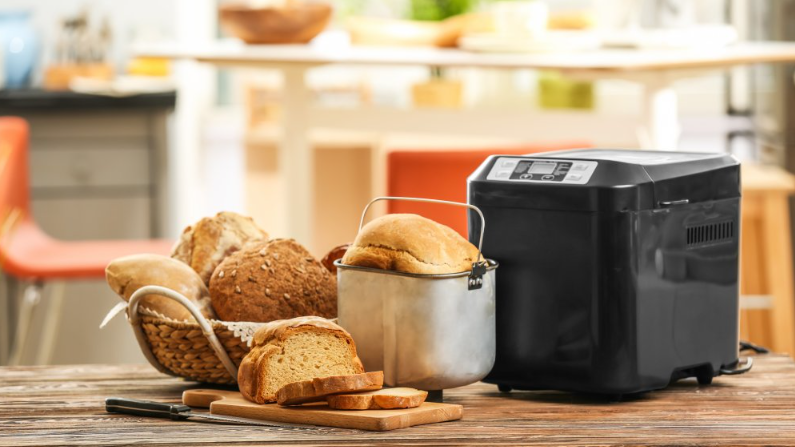
Content
Introducing the Breadman BREAD MAKER BK1060S
The Breadman BREAD MAKER BK1060S is a versatile and easy-to-use bread maker that allows you to create delicious homemade bread in no time. This bread maker features a sleek design and a variety of settings to help you make the perfect loaf of bread, every time. With an estimated price range of $100 to $150 and a launching date of January 2021, the Breadman BREAD MAKER BK1060S is a great addition to any kitchen.
BK1060S Included Parts
Product may vary slightly from what is illustrated.
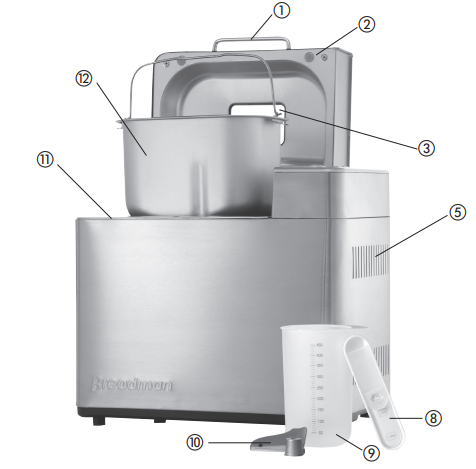
- Lid handle
- Removable lid (Part # BK1060S-01)
- Viewing window
- Automatic fruit & nut dispenser (not shown)
- Steam vents (both sides)
- Control panel (not shown)
- On/Off (I/O) switch (not shown, back right side)
- Measuring spoon (Part # BK1060S-05)
- Measuring cup (Part # BK1060S-04)
- Collapsible kneading paddle (Part # BK1060S-03)
- Baking chamber
- Bread pan (Part # BK1060S-02)
Note: Indicates consumer replaceable/removable parts
Detailed Specifications of Breadman
The Breadman BREAD MAKER BK1060S has the following key features:
- 17 settings for various bread, dough, and jam options
- 3 crust colors (light, medium, and dark)
- 3 loaf sizes (1.5, 2, and 2.5 pounds)
- Delay timer up to 15 hours
- Viewing window to check on the bread while it's baking
- Non-stick, removable baking pan
- Measurement cup and spoon included
- Cool-touch exterior
- LCD display
- Power interrupt protection
CONTROL PANEL

- DISPLAY WINDOW
Shows selection and timer setting. - TIMER ▲ AND ▼ BUTTONS
Use this pair of buttons to adjust the BAKE ONLY time and to set delay bake timer; buttons add or subtract time displayed in the display window.- ▲ Increases time in 10-minute intervals.
- ▼ Decreases time in 10-minute intervals.
- XLOAF SIZE BUTTON
Selects loaf size: 1-lb., 1½-lb. or 2-lb. Loaf size default is 2-lb. Rapid loaf is preset to 2-lb. - MENU BUTTON
Selects cycle. Each time the MENU button is pressed, the number for the cycle selected and the program time will appear in the display window. - BAKE ONLY BUTTON
Use this button to activate the BAKE ONLY cycle; then adjust the time as needed with the ▲ and ▼ buttons. - CRUST COLOR BUTTON
Selects crust color: light, medium or dark. Crust color is preset to medium. - START/STOP BUTTON
Press and hold for several seconds to clear display, reset cycle or to simply stop baking.
Note: When using Rapid bake, your crust color will be set to medium.
IMPORTANT SAFEGUARDS
When using electrical appliances, basic safety precautions should always be followed including the following:
- Read all instructions.
- Do not touch hot surfaces. Use handles or knobs.
- To protect against electrical shock do not immerse cord, plugs, or appliance in water or other liquid.
- Close supervision is necessary when any appliance is used by or near children.
- Unplug from outlet when not in use and before cleaning. Allow to cool before putting on or taking off parts.
- Do not operate any appliance with a damaged cord or plug, or after the appliance malfunctions or has been damaged in any manner. Contact Consumer Services for examination, repair or electrical or mechanical adjustment. Or, call the appropriate toll-free number on the cover of this manual.
- The use of accessory attachments not recommended by the appliance manufacturer may cause fire, electric shock or injury.
- Do not use outdoors.
- Do not let cord hang over edge of table or counter, or touch hot surfaces, including the stove.
- Do not place on or near a hot gas or electric burner, or in a heated oven.
- Extreme caution must be used when moving an appliance containing hot oil or other hot liquids.
- To disconnect, press and hold the STOP button for several seconds, remove plug from wall outlet.
- Do not use appliance for other than intended use.
- Avoid contacting moving parts.
POLARIZED PLUG (120V Models Only)
This appliance has a polarized plug (one blade is wider than the other). To reduce the risk of electric shock, this plug is intended to fit into a polarized outlet only one way. If the plug does not fit fully into the outlet, reverse the plug. If it still does not fit, contact a qualified electrician. Do not attempt to modify the plug in any way.
TAMPER-RESISTANT SCREW
Warning: This appliance is equipped with a tamper-resistant screw to prevent removal of the outer cover. To reduce the risk of fire or electric shock, do not attempt to remove the outer cover. There are no user-serviceable parts inside. Repair should be done only by authorized service personnel.
ELECTRICAL CORD
- A short power-supply cord (or detachable power-supply cord) is to be provided to reduce the risk resulting from becoming entangled in or tripping over a longer cord.
- Longer detachable power-supply cords or extension cords are available and may be used if care is exercised in their use.
- If a long detachable power-supply cord or extension cord is used,
- The marked electrical rating of the detachable power-supply cord or extension cord should be at least as great as the electrical rating of the appliance,
- the appliance is of the grounded type, the extension cord should be a grounding-type 3-wire cord, and
- The longer cord should be arranged so that it will not drape over the countertop or tabletop where it can be pulled on by children or tripped over.
Note: If the power supply cord is damaged, it should be replaced by qualified personnel; in Latin America, by an authorized service center.
POWER OUTAGE
10-Minute Power Failure Back-Up
Your Professional Bread Maker has a 10-minute power failure back-up feature. If the electricity goes out, the memory will store your cycle selection for up to 10 minutes. If the power comes back on within this time, bread making will resume where it left off.
If the bread maker loses power for more than 10 minutes and you are using any dairy products, perishables or meat in your bread, you should discard the contents of the recipe and start again with new fresh ingredients due to health and sanitary considerations. For nonperishable recipes you may try starting the bread maker at the beginning of the cycle again. However, this may not always produce an acceptable loaf of bread.
If you are not sure when the outage occurred, remove the dough and discard.
KNEADING AND BAKING CYCLES
Note: If at any time during bread making process you need to turn bread maker off, press and hold the START/STOP button for several seconds, then unplug the unit.
Note: If bread is not removed immediately after baking and START/STOP button is not pressed, a controlled 60-minute Keep Warm mode will begin (except during Quick Bread, Dough and Jam). For best results, remove bread immediately after baking process is complete.
- WHITE
Used for breads that primarily include white bread flour, although some recipes may include small amounts of whole wheat flour. - WHOLE WHEAT
Used for recipes with significant amounts of whole wheat or rye flour, oats or bran. Whole wheat cycle begins with rest period during which flours or grains absorb liquid ingredients. Soaking causes flour or grain to soften and helps ingredients to combine. Generally, whole wheat and multi-grain breads are shorter and denser than white, French or sweet. - FRENCH
Traditionally, French bread has a slightly crispier crust and lighter texture than white bread. Recipes usually do not include butter, margarine or milk. - SWEET
Used for recipes that contain eggs, fruit juice, additional sugar or added sweet ingredients such as coconut flakes, raisins, dried fruit or chocolate. Baking temperature is reduced to prevent burning. - QUICK BREAD
Used for recipes that contain baking powder or baking soda, rather than yeast, to make bread rise. Cake recipes made from scratch must be specially designed for this cycle. - LOW CARB
Used for recipes that are lower in carbohydrates. - GLUTEN-FREE
Used for gluten-free recipes. - DOUGH
Use to prepare dough for making bread, rolls or pizza which are shaped and allowed to rise before baking in a conventional oven. This setting blends and kneads the dough and takes it through the first rise. - ARTISAN DOUGH
Artisan breads (or country breads) represent the best in bread baking. They use the freshest ingredients, usually including fresh herbs and interesting seed and nut additions. The longer rising
time (the entire cycle in the bread machine is 5:15 hours) at cooler temperature settings (preset in the machine) allow the flavor of the flour to dominate. Consider using ingredients such as, organic flours, unrefined sea salt and spring water. Sugar and fat are often not used in these breads. The final shaping, rising and baking of the bread allow for your creativity and bring a very personal touch to the results. - JAM
Use to prepare preserves, marmalade, chutneys and ketchup. Add fruit, sugar and lemon juice for homemade preserves – a great topping for homemade bread, waffles and ice cream. - BAKE ONLY
Used if crust is too light or you wish to bake pre-made dough – also especially useful if your bread is not quite done. Check every few minutes. Bakes for up to 1 hour, 30 minutes. - RAPID
Used for White, Whole Wheat and French cycles to decrease time to approximately 1 hour. Choose recipe, then simply add ½ tsp. to amount of yeast listed for a 2-lb. loaf. Bread may be shorter and denser than bread made using the longer program.
Breadman BREAD MAKER BK1060S KNOW YOUR INGREDIENTS
| Flour & Other Grains | Description |
|---|---|
| ALL-PURPOSE FLOUR | All-purpose flour is a blend of refined hard and soft wheat flours ideally suited for making quick breads and cakes. |
| BRAN | Bran (unprocessed) is coarse outer portion of wheat or rye grains that is separated from flour by sifting or bolting. It is often added to bread in small quantities for nutritional enrichment, heartiness and flavor. It is also used to enhance bread texture. |
| BREAD FLOUR | Bread flour typically has higher gluten concentration than all-purpose flour. Using bread flour will produce loaves with better volume and structure. |
| CORNMEAL AND OATMEAL | Cornmeal and oatmeal come from coarsely ground white or yellow corn and from rolled or steel-cut oats. They are used primarily to enhance flavor and texture of bread. |
| CRACKED WHEAT | Cracked wheat has very coarse texture. It comes from wheat kernels cut into angular fragments. It gives whole grain breads a nutty flavor and crunchy texture. |
| RYE FLOUR | Rye flour must always be mixed with high proportion of bread flour, as it does not contain enough gluten to develop structure for high, even-grained loaf. |
| SELF-RISING FLOUR | Self-Rising Flour is NOT RECOMMENDED for use with your bread maker. Self-rising flour contains leavening ingredients that will interfere with bread and quick bread making. |
| 7 GRAIN CEREAL BLEND | 7 grain cereal blend is a blend of cracked wheat, oats, bran, rye, cornmeal, flax seeds and hulled millet. It is used primarily to enhance flavor and texture of bread. |
| VITAL WHEAT GLUTEN | Vital Wheat Gluten is manufactured from wheat flour that has been treated to remove nearly all of the starch to leave a very high protein content. (Gluten is the protein in wheat that makes dough elastic.) Vital Wheat Gluten is available at most health food stores. It can be used in small portions to increase volume and lighten texture. |
| WHOLE WHEAT FLOUR | Whole wheat flour is milled from the entire wheat kernel, which contains the bran and germ. This high fiber flour is richer in nutrients than all-purpose or bread flour. Breads made with this flour are usually smaller and heavier than white loaves. Many recipes mix whole wheat flour with bread flour or vital wheat gluten to produce higher, lighter-textured bread. |
TIPS ON FLOUR STORAGE
Keep flour in a secure, airtight container. Store rye and whole wheat flours in a refrigerator, freezer or a cool area to prevent them from becoming rancid. Allow flour to come to room temperature before using.
Note: Flours, while visibly similar, can be very different in how they are ground, milled, stored, etc. You may have to experiment with different brands of flour to help you make the perfect loaf. See RECIPE TIPS to assist with these experiments.
YEAST
Active yeast, through a fermentation process, produces carbon dioxide gas necessary to make bread rise. Yeast feeds on carbohydrates in sugar and flour to produce this gas. Three different types of yeast are available: fresh (cake), active dry and quick-acting. Quick, rapid rise and bread machine yeasts are quick-acting. Fresh (cake) yeast is NOT RECOMMENDED for use with your bread maker.
TIPS ON YEAST
Ensure your yeast is fresh by checking its expiration date. Ideally, yeast should be used several months before the expiration date. Once a package or jar of yeast is opened, it is important that the remaining contents be immediately resealed and refrigerated or frozen for future use. Often dough that fails to rise is due to stale yeast.
Note: Basic bread and dough recipes in this booklet were developed using bread machine yeasy (active dry yeast). You may use chart to substitute any quick-acting yeast (quick rise or fast rise) for bread machine yeast.
CONVERSION CHART FOR BREAD MACHINE YEAST
- ¾ tsp. bread machine yeast = ½ tsp. quick-acting yeast
- 1 tsp. bread machine yeast = ¾ tsp. quick-acting yeast
- 1½ tsp. bread machine yeast = 1 tsp. quick-acting yeast
- 2¼ tsp. bread machine yeast = 1½ tsp. quick-acting yeast
- 1 tbsp. bread machine yeast = 2 tsp. quick-acting yeast
RAPID CYCLES
Rapid cycle settings for White, Whole Wheat and French decrease time for making your favorite bread in approximately 1 hour. Choose recipe, then add an additional ½ tsp. of bread machine yeast to the recipe. The bread may be shorter and denser.
| Ingredient | Notes |
|---|---|
| BAKING POWDER | Double-acting baking powder is a leavening agent used in quick breads and cakes. This type of leavening agent does not require rising time before baking, as the chemical reaction works when liquid ingredients are added and again during the baking process. |
| BAKING SODA | Baking soda is another leavening agent, not to be confused or substituted for baking powder. It also does not require rising time before baking, as the chemical reaction works during the baking process. |
| EGGS | Eggs add richness and velvety texture to bread dough and cakes. When a recipe calls for eggs, large eggs at room temperature should be used. |
| FATS | Butter, margarine, and oil shorten or tenderize the texture of yeast breads. French bread gets its unique crust and texture from the lack of added fat. However, breads that call for fat stay fresh longer. If butter is used directly from the refrigerator, it should be cut into small pieces for easier blending during the kneading process. |
| LIQUIDS | All liquids should be warm 80°F/27°C to 90°F/32°C for all recipes. Liquids, such as milk, water, or a combination of powdered milk and water, can be used when making bread. Milk will improve flavor, provide velvety texture, and soften the crust, while water alone will produce a crispier crust. Vegetable or fruit juices and potato water may be used for flavor variety. |
| SALT | Salt is necessary to balance flavor in breads and cakes; it also limits the growth of yeast. Changing the amount of salt in a given recipe may result in shorter, gummier bread. When first making a type of bread, do not increase or decrease the amount of salt shown in the recipe. |
| SUGAR | Sugar is important for color and flavor of breads. It also serves as food for yeast since it supports the fermentation process. Recipes in this book that call for sugar require granulated sugar. Important: Do not substitute powdered sugar. Artificial sweeteners cannot be used as a substitute, as yeast will not react properly with them. |
Description about Breadman BREAD MAKER BK1060S
The Breadman BREAD MAKER BK1060S is a high-quality bread maker that is perfect for both beginners and experienced bakers. With 17 settings, you can easily make a variety of breads, doughs, and jams. The bread maker also features a delay timer, so you can have fresh bread ready when you wake up or come home from work. The viewing window allows you to keep an eye on the bread while it's baking, and the cool-touch exterior ensures that the bread maker stays safe to touch. The non-stick, removable baking pan makes cleaning a breeze, and the included measurement cup and spoon help ensure that your bread turns out perfect every time.
CLIMATE CHANGES & BAKING
- In high-altitude areas (over 3,000 feet) dough tends to rise faster, as there is less air pressure. Therefore, less yeast is necessary.
- In dry climates, flour is drier and requires slightly more liquid.
- In humid climates, flour is wetter and will absorb less liquid, so less liquid is required.
How to Use
This product is for household use only.
Important: Your bread maker has an Intelligent Fuse™ system designed to protect the motor from overheating. It will automatically shut off the motor if there is an overheat risk. If this occurs, unplug the appliance, wait a minimum of 20 minutes for it to cool down, and plug in again following the instructions.
GETTING STARTED
- Remove packing materials and any stickers.
- Please go to www.prodprotect.com/applica to register your warranty.
- Place bread maker on dry, stable, level surface away from heat and areas where cooking grease or water may splatter on unit. Do not place near edge of countertop. If placing beneath cabinets, make sure there is enough room to open the lid without interference.
Important: Your bread maker will bake up at a 2-lb. loaf. Do not put larger quantities of ingredients into bread pan. Bread will not mix and bake correctly and bread maker may be damaged. (See MAXIMUM INGREDIENT AMOUNTS.) - Before first use, operate on Rapid White cycle without adding ingredients to burn off manufacturing oils. (Follow instructions in USING YOUR BREAD MAKER.)
MAXIMUM INGREDIENT AMOUNTS
- Bread cycles: approximately 5 cups
- Quick breads: 4 cups
- Dough cycle: 42/3 cups
- Jam: 3 cups of fruit mixture BREAD PAN TIPS
Inserting bread pan
Note: Remember to insert kneading paddle first, then add all ingredients in the order listed BEFORE inserting the bread pan into baking chamber.
Important: The collapsible kneading paddle may fall when ingredients are added. This is normal. It will stand up when kneading begins. When inserting bread pan into bread maker, make sure to set firmly in place.
Removing bread pan: To remove bread pan from baking chamber, hold handle with an oven mitt and lift straight up firmly.
Important: When you remove bread pan after baking, be sure to wear oven mitts to prevent burning. After removing loaf (by turning bread pan upside down and shaking gently), check to see that kneading paddle is removed from loaf. If it is stuck in bread, allow bread to cool. Allow bread to cool before removing the kneading paddle.
CHECKING DOUGH CONSISTENCY
Although your bread maker will mix, knead and bake bread automatically, when baking bread from scratch, it is recommended that you learn to recognize condition of your dough. The ratio of flour to liquid is the most critical factor in any bread recipe, yet the most easily remedied. After 5 to 8 minutes in Knead 2, open bread maker to check consistency of dough. Dough should be in a soft, tacky ball (feel sticky like scotch tape). If it is too dry, add 1 tbsp. of liquid at a time. If it is too wet, add 1 tbsp. of flour at a time.
USING YOUR BREAD MAKER
Note: Depending on the cycle or recipe used, some steps may not apply or there may be additional steps. Refer to the respective recipes instructions in the recipes portion of this booklet, as well
as the specific cycle instructions located at the end of these usage instructions.
- Open lid and remove bread pan. Lift bread pan straight up and out using the handle (B).
Caution: Do not turn or shake bread pan while taking it out. If the bread pan is bent, temperature sensor may not work properly. Position kneading paddle on the drive shaft. Match flat side of drive shaft to flat part of hole in kneading paddle (C). Make sure paddle is secure.
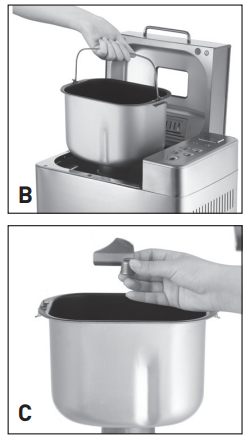
- Place ingredients into the bread pan.
Note: As you add ingredients into the bread pan, the collapsible kneading paddle may fall; this is normal. The paddle will stand up automatically once the cycle is started.
Important: Add ingredients to bread pan in the order listed in the recipe.
Important: Always add yeast last. - Make small indentation on top of dry ingredients (not so deep it reaches the wet layer) and add yeast (D).
Important: Indentation for yeast is important, especially when using the delay bake timer. It keeps yeast away from the wet ingredients until the kneading process begins. (Liquid ingredients will prematurely activate the yeast.) Insert the bread pan into the baking chamber (E). Press down on rim of bread pan until it snaps securely into place.
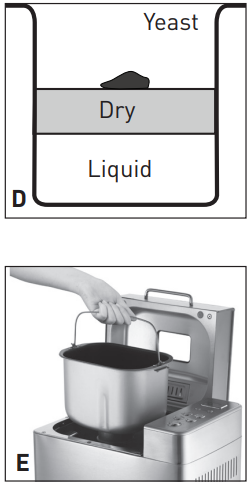
- Close the lid. If your recipe includes extra ingredients such as fruits or nuts (listed after the yeast in the recipe), add these to the automatic fruit and dispenser.
Important: Do not exceed 2/3 cup capacity.
Important: Do not pour liquids or spices into dispenser. Always make sure fresh fruit or vegetables are not wet; pat dry before putting them in the dispenser. - Plug into standard electrical outlet. Turn the On/Off (I/O) switch to the on (I) position. Bread maker will beep and program 1 and 3:25 will appear in the display window (F).
- Press MENU to choose desired cycle (F1). Each time MENU is pressed, unit and display will move to the next cycle.
Note: As the MENU button is pressed, the Rapid cycle setting will follow the regular cycle setting for White, Whole Wheat and French. - Press CRUST COLOR to choose crust color (F2). Bread maker is preset for medium crust.
Note: CRUST will not be activated for the following cycles: Jam, Dough, Artisan Dough, Bake Only, Rapid Press LOAF SIZE to select loaf size (F3). Bread maker is preset to 2 lb.
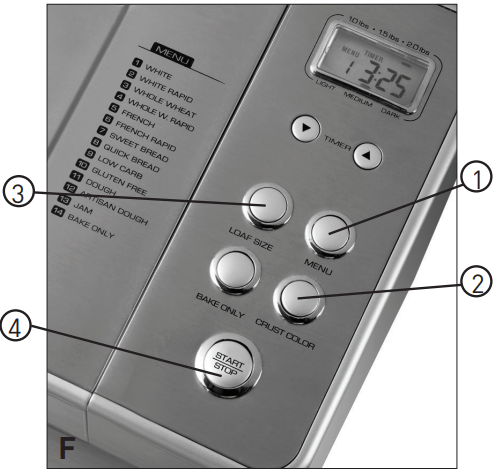
Note: Loaf size cannot be activated for the following cycles: Jam, Dough, Artisan Dough, Rapid, Gluten Free, Low Carb
- Press START/STOP button 4 to begin kneading cycle (F4). The time remaining will begin to count down in display window. Bread making time and loaf size will be shown in display window.
Note: During kneading cycle, yeast will activate and viewing window may begin to fog. (This will clear eventually so you can view the progress.) When your bread is finished baking, bread maker will beep and “3:25” will appear in display window. Press START/STOP and open lid. Using oven mitts, remove bread pan (G).
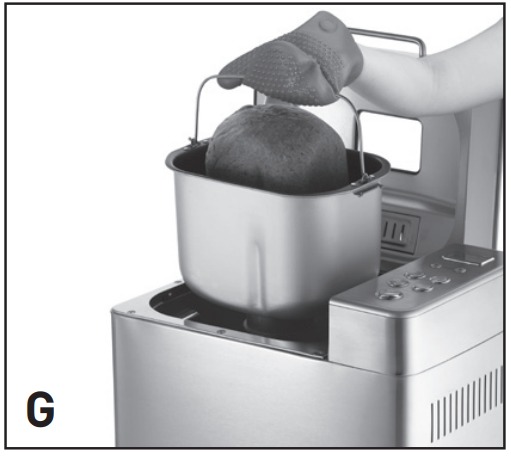
Important: Remember, bread pan and loaf are both very hot! Be careful not to place either on tablecloth, plastic surface or other heat-sensitive surface that may scorch or melt.
Note: If bread is not removed immediately after baking and START/ STOP is not pressed, the Keep Warm mode will begin. Bread maker will automatically turn off after 60 minutes. For best results, remove bread immediately after baking.
Note: Keep Warm does not apply to the following cycles: Jam, Dough, Artisan Dough, Bake Only- Turn bread pan upside down and shake to release bread (H). Place bread upright on wire rack to cool at least 20 minutes before slicing.
Note: The collapsible kneading paddle is designed to stay in the bread pan instead of sticking in your bread. Check to see if the paddle stayed in the pan. If not, follow the caution statements below when removing.
Caution: Be sure to remove kneading paddle from the bread before serving.
Caution: Bread pan, kneading paddle and bread will be very hot. Allow bread to cool before removing the paddle. - Turn the On/Off (I/O) switch to the off (O) position. Unplug unit and allow to cool completely before cleaning. (See CARE AND CLEANING INSTRUCTIONS.)
Important: Make sure to clean the inside of the baking chamber thoroughly after each use. Once bread has cooled (approximately 2 hours) store in an airtight container.

SLICING AND STORING BREAD
For best results, place bread on wire rack and allow to cool at least 20 minutes before slicing. Use electric knife or serrated knife for even slices. Store unused bread, tightly sealed (sealable plastic bags or plastic containers work well) at room temperature for up to 3 days. For longer storage, (up to 1 month) place bread in sealed container in freezer. Since homemade bread has no preservatives, it tends to dry out and become stale faster. Leftover or slightly hardened bread may be cut into ½-inch or 1-inch cubes and used in recipes to make croutons, bread pudding or stuffing.
USING 15-HOUR DELAY BAKE TIMER
Important: Delay baking does not activate JAM cycle. Do not use delay bake timer if your recipe includes perishables, such as eggs, fresh milk, yogurt or other dairy products and meats, etc. To preset your bread maker, follow these steps:
To preset your bread maker, follow these steps:
- Add ingredients in the order listed as usual, taking care not to let yeast and liquid ingredients contact one another.
Note: If your recipe contains salt, add it with the liquid ingredients, taking care to keep it away from the yeast. - Close bread maker lid and plug it in.
- Press MENU to select baking cycle. Standard cycle time will be shown in display window.
- Press ▲ to add time in 10-minute intervals. (Use ▼ to subtract time.) Amount of time set is shown in display window.
- To fast forward time, continually press ▲.
- To fast reverse, continually press ▼.
- For example, if it is 8:00 AM and you want bread ready at 1:00 PM, press ▲ until the display reads 5:00 – meaning it will finish baking in 5 hours. This is the hour difference between 8:00 AM and 1:00 PM.
Note: Actual baking times will not change.
- Press LOAF SIZE to choose loaf size, press CRUST COLOR to choose crust color, then press START/STOP to begin timer. The colon (:) in time display begins to flash, letting you know timer is started. When your bread is finished baking, bread maker will beep and “0:00” will appear in display window. Press START/STOP and open lid.
- If you make an error after you’ve activated program and want to start over, press and hold START/STOP for several seconds. Timer will clear and you can begin again.
BAKE ONLY
The BAKE ONLY cycle offers the flexibility to vary time. You can bake pre-made dough or dough purchased at the store using this cycle. You may also use this cycle if crust color is too light or if your sweet bread is not quite done. Check every few minutes.
- Press the BAKE ONLY button to activate cycle. Adjust the amount of time you need up to 1½ hours using the ▲ and ▼ buttons.
- Press START/STOP button to begin baking.
SPECIAL GLAZES FOR YEAST BREADS
Select 1 of the following special glazes to enhance your bread:
- Melted Butter Crust: Brush melted butter over just-baked bread for a softer, more tender crust.
- Milk Glaze: For a softer, shiny crust, brush just-baked bread with milk or cream.
- Sweet Icing Glaze: Mix 1 cup sifted confectioner’s sugar with 1 to 2 tablespoons of milk, water or fruit juice until smooth. Drizzle glaze over raisin or sweet bread when they are almost cool.
Note: If desired, generously sprinkle with your choice of nuts or seeds after glazing.
Care and Cleaning of Breadman BREAD MAKER BK1060S
This product contains no user serviceable parts. Refer service to qualified service personnel.
CLEANING
Important: Always unplug bread maker and allow to cool completely prior to cleaning. Bread pan and kneading paddle have nonstick surfaces, which make cleaning easier.
- After baking each loaf of bread, unplug bread maker and allow to cool; discard any crumbs.
- Remove bread pan from oven chamber and kneading paddle from bread pan. Wash bread pan and kneading paddle inside and out with warm, soapy water. Avoid scratching nonstick surfaces.
Caution: Do not place bread pan in dishwasher, or soak it in water. - If kneading paddle is stuck to drive shaft, pour warm water into bread pan for up to 30 minutes, to loosen it. Do not use excessive force.
- Wipe inside of lid and oven baking chamber with slightly damp cloth or sponge. If any residue has scorched on heating element or elsewhere, wipe with nonabrasive pad to clean. Lid can be removed for cleaning. Dry baking chamber and lid thoroughly.
Important: Do not put lid in dishwasher, as it may cause warping. Do not immerse in water, as it contains sensitive electronic sensors. - To clean glass in lid, use glass cleaner or mild detergent and damp cloth or plastic scouring pad. Do not use abrasive cleaners or scouring pads, as they may scratch glass.
- Do not use vinegar, bleach or harsh chemicals to clean bread maker.
- Be sure bread maker is completely cooled before storing.
- Baking chamber contains heating element and drive shaft. When cleaning, NEVER pour water, solvents or cleaning solutions into this area.
STORAGE
- All removable parts should be thoroughly cleaned and dried.
- Store lid closed. Place bread pan into bread maker with kneading paddle inside.
TROUBLESHOOTING
| Question | Answer |
|---|---|
| Why does height and shape of bread differ in each loaf? | Height and shape of bread may differ depending on the ingredients, room temperature, and length of timer cycle. Also, accurate measurement of ingredients is essential to make delicious bread. |
| Bread has unusual aroma. Why? | Stale ingredients may have been used or too much yeast may have been used. Always use fresh ingredients. Accurate measurements are essential to make delicious bread. |
| Kneading paddle comes out with bread. | This can happen, as the kneading paddle is detachable. Use a nonmetal utensil to remove it. Caution: Kneading paddle will be hot. Allow bread to cool before removing the paddle. |
| Bread has floured corners. | Sometimes flour in the corners of the bread pan may not have been completely kneaded into the dough. Scrape it off the loaf with a knife. Check bread about 10 minutes into the kneading cycle. If all flour is not incorporated, use a rubber spatula to remove the flour from the sides of the bread pan so it can be incorporated into the dough. |
| Can ingredients be halved or doubled? | NO. If there is too little in the bread pan, the kneading paddle cannot knead well enough. If there is too much, bread rises out of the bread pan. |
| Can fresh milk be used in place of dry milk? | YES. Be sure to decrease the same measurement of water to equal liquid substitution. Fresh milk is not recommended when using a delay bake timer because it may spoil while sitting in the bread pan. |
Breadman BREAD MAKER BK1060S Warranty
- Two-Year Limited Warranty
(Applies only in the United States and Canada) - What does it cover?
Any defect in material or workmanship provided; however, Applica’s liability will not exceed the purchase price of product. - For how long?
Two years from the date of original purchase with proof of such purchase. - What will we do to help you?
Provide you with a reasonably similar replacement product that is either new or factory refurbished.
Pros & Cons
Pros
- 17 settings for various bread, dough, and jam options
- 3 crust colors and loaf sizes
- Delay timer up to 15 hours
- Viewing window and cool-touch exterior
- Non-stick, removable baking pan
- Power interrupt protection
Cons
- No gluten-free setting
- No nut and seed dispenser
- No recipe book included
- Some users have reported issues with the bread maker's durability
Customer Reviews
Customers have praised the Breadman BREAD MAKER BK1060S for its ease of use and versatility. However, some users have reported issues with the bread maker's durability. The most common complaints include the bread maker breaking down after a few months of use and the plastic parts breaking easily.
Faqs
What exactly is the Breadman Breadmaker BK1060S, and how does it work?
Where can I find the Breadman Bread Maker BK1060S, and what kinds of bread can I create with it?
Is it possible to use the Breadman Bread Maker BK1060S with the bread recipe that I have created?
In the event that my Breadman Bread Machine BK1060S does not rise as well as it should, what should I do?
What is the proper way to tidy up the Breadman Bread Maker BK1060S?
How should I proceed if the bread becomes stuck to the pan that comes with the Breadman Bread Maker BK1060S?
When using the BK1060S, is it possible to utilize whole wheat flour?
Does the Breadman Bread Maker BK1060S allow for adjustments to be made to the baking cycle while it is in progress?
How long does it take to make a loaf of bread with the Breadman BREAD MAKER BK1060S?
Where can I get information regarding the bread maker BK1060S from Breadman?
Leave a Comment
